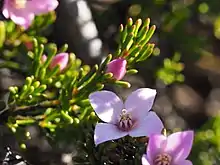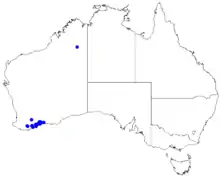Boronia oxyantha
Boronia oxyantha is a plant in the citrus family, Rutaceae and is endemic to a small area in the south-west of Western Australia. It is a shrub with many hairy branches, pinnate leaves and pink, four-petalled flowers that have a darker midrib.

| Boronia oxyantha | |
|---|---|
 | |
| Boronia oxyantha near Ravensthorpe | |
| Scientific classification | |
| Kingdom: | Plantae |
| Clade: | Tracheophytes |
| Clade: | Angiosperms |
| Clade: | Eudicots |
| Clade: | Rosids |
| Order: | Sapindales |
| Family: | Rutaceae |
| Genus: | Boronia |
| Species: | B. oxyantha |
| Binomial name | |
| Boronia oxyantha | |
 | |
| Occurrence data from Australasian Virtual Herbarium | |
Description
Boronia oxyantha is a shrub with many hairy branches and that grows to a height of about 60 cm (24 in). The leaves are compound and often crowded, with between three and seven leaflets on a petiole 0.5–2 mm (0.020–0.079 in) long. The leaflets are narrow club-shaped and 3–7 mm (0.12–0.28 in) long. The flowers are arranged singly in leaf axils on a pedicel about 2 mm (0.079 in) long. The four sepals are narrow triangular, about 2–3.5 mm (0.08–0.1 in) long and hairless. The four petals are broadly elliptic, pink with a darker midrib and about 7 mm (0.3 in) long with scattered, soft hairs. The ten stamens have a few soft hairs and a prominent swelling on the tip. The stigma is minute. Flowering occurs from August to December or February.[2][3]
Taxonomy and naming
Boronia oxyantha was first formally described in 1852 by Nikolai Turczaninow and the description was published in Bulletin de la Société Impériale des Naturalistes de Moscou.[4][5] The specific epithet (oxyantha) is derived from the ancient Greek words oxys (ὀξύς) meaning "sharp" and anthos (ἄνθος) meaning "flower".[6]
Distribution and habitat
This boronia grows on breakaways and slopes between Ongerup and Hopetoun in the Mallee biogeographic region.[2][3]
Conservation
Boronia oxyantha is classified as "not threatened" by the Western Australian Government Department of Parks and Wildlife.[2]
References
- "Boronia oxyantha". Australian Plant Census. Retrieved 8 April 2019.
- "Boronia oxyantha". FloraBase. Western Australian Government Department of Parks and Wildlife.
- Duretto, Marco F.; Wilson, Paul G.; Ladiges, Pauline Y. "Boronia oxyantha". Flora of Australia. Australian Biological Resources Study, Department of the Environment and Energy, Canberra. Retrieved 8 April 2019.
- "Boronia oxyantha". APNI. Retrieved 8 April 2019.
- Turczaninow, Nikolai (1852). "Decas septima generum adhuc non descriptorum adjectis descriptionibus nonnullarum specierum". Bulletin de la Société Impériale des Naturalistes de Moscou. 25 (3): 165. Retrieved 11 February 2019.
- Backer, C.A. (1936). Verklarend woordenboek der wetenschappelijke namen van de in Nederland en Nederlandsch-Indië in het wild groeiende en in tuinen en parken gekweekte varens en hoogere planten (Edition Nicoline van der Sijs).